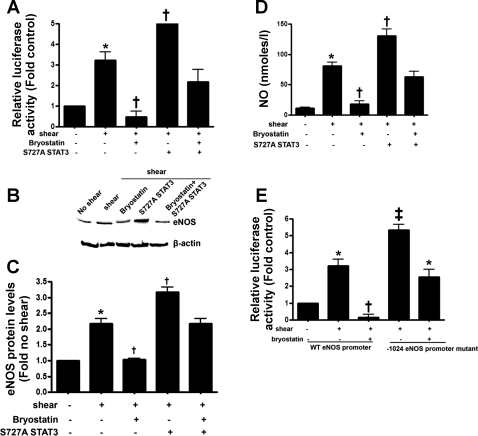Fig. 5.
Effect of STAT3 inhibition on eNOS expression and activity in response to shear stress. To examine the effect of inhibiting STAT3 activity on eNOS promoter activity, cells were also transfected with a 1.6-kb eNOS promoter-luciferase reporter construct (along with β-galactosidase as an internal control) or a construct in which the STAT3 binding element at −1,024 was mutated along with a dominant mutant of STAT3, S727A STAT3. After 24 h, the cells were then treated or not with bryostatin (10 ng/ml, 30 min before shear) and then exposed to shear stress (20 dyn/cm2, 8 h). The increase in the activity of the eNOS promoter induced by shear stress is significantly increased by S727A STAT3 overexpression (A). The inhibitory effect of bryostatin is also blocked by S727A STAT3 overexpression (A). Similarly, S727A STAT3 overexpression significantly increases the shear-mediated increase in both eNOS protein levels (B and C) and NO generation (D). S727A STAT3 overexpression also reverses the effect of bryostatin on eNOS protein levels (B and C) and NO generation (D). In addition, shear stress significantly enhances the activity of the STAT3 mutant eNOS promoter compared with the wild-type promoter and this is not attenuated by bryostatin (E). Values are means ± SD. *P < 0.05 vs. no shear, †P < 0.05 vs. shear alone, ‡P < 0.05 vs. wild-type promoter; n = 6.

